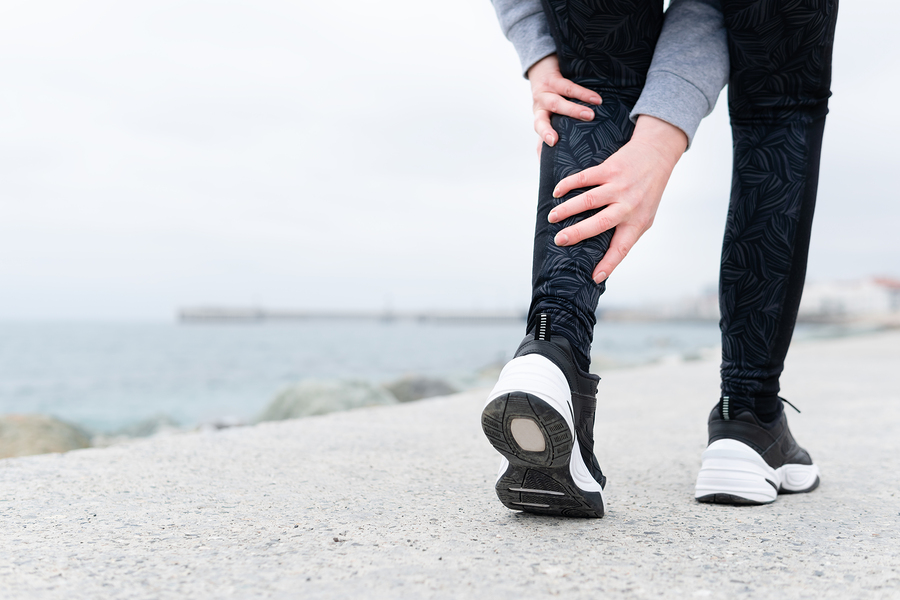Calf muscle strain – symptoms and treatment
Unfortunately, it is almost inevitable that if we play sport or exercise hard then most of us will suffer a calf muscle strain at some point.
Here we take a look at symptoms, the grading of strains and treatment available.
Symptoms of stretched or torn calf muscle fibres
Symptoms will depend on the grade of strain but may include:
- A distinct pop, snap or twinge at the time of injury
- Calf spasm
- Throbbing, tightness or weakness in the area
- Pain in the leg when moving
- An inability to run or jump on the affected leg
- Bruising
How do we get calf strain?
Calf strain typically occurs in sports where there are sudden changes in direction or jumping such as football, squash or tennis. The muscle fibres then become over stretched and may rupture as a result.
Grading
Muscle strains are graded from 1 – 3 with a grade 3 tear being the most severe. Grading of a strain is dependent on symptoms, recovery and how many of the muscle fibres have ruptured. A grade 3 strain for example will typically have nearly 100% ruptured muscle fibres.
Grade 1 strain:
- A snap or twinge may be heard or felt at the time of the injury
- A sports person will often continue but discomfort will increase following the injury
- Tightness or aching in the calf muscle generally occurs 24 hours afterwards
- Recovery takes 2 to 4 weeks and doesn’t usually warrant an appointment with a healthcare professional
- Muscle fibres are overstretched rather than torn.
If, however, symptoms do not improve after a couple of weeks, or indeed worsen, then it would be advisable to see a healthcare professional.
Grade 2 strain:
- There is significant pain at the time of the injury
- Difficulty walking
- Bruising
- A snap may be heard or a twinge may be felt
- Recovery may take 4 to 8 weeks
- A greater number of muscle fibres are torn rather than overstretched.
Grade 3 strain:
- Significant pain and it is unlikely that a sportsperson will be able to continue
- A pop may be heard
- Difficulty in using the leg
- Most of the fibres (possibly 100%) will have actually ruptured
- Recovery can be greater than 3 months
- Input will be needed from your GP and physiotherapist to help you recover
How to manage a strain:
Home management of a grade 1 strain is:
- Protection
- Rest
- Ice
- Compression
- Elevation
However, if you think you may have torn rather than over stretched your muscle fibres then we would suggest that you contact your GP or physiotherapist to confirm the diagnosis and the grade of the strain that you have.
A GP assessment may include:
- Advice on how best to resume sports activities
- Massage
- Heat packs
- Paracetamol or possibly codeine
- When and if a physiotherapy consultation is needed
- Non-steroidal anti-inflammatory medication
- If immobilisation of the injury is needed – when to use a cast, brace or splint
- If surgery should be considered.
Click here for prevention and treatment of some of the most common sports injuries
Disclaimer
All content on Silversurfers.com is provided for general information only, and should not be treated at all as a substitute for the medical advice of your own doctor or any other health care professional. Silversurfers will not be responsible or liable for any diagnosis made by a user based on the content on www.silversurfers.com and we are also not liable for the content of any external websites or links from or to Silversurfers to any other websites. Please always consult your own doctor if you’re in any way concerned about any aspect of your health
Melina - Assistant Editor
Latest posts by Melina - Assistant Editor (see all)
- Remembering the Big Freeze of 1963 - November 21, 2024
- Is your hot water bottle safe to use? Tips on what to look out for - November 20, 2024
- Tips on dealing with a frozen windscreen without using a spray de-icer - November 19, 2024
- 5 Homemade edible gifts in a jar - November 15, 2024
- The best of the Rolling Stones - October 22, 2024





















